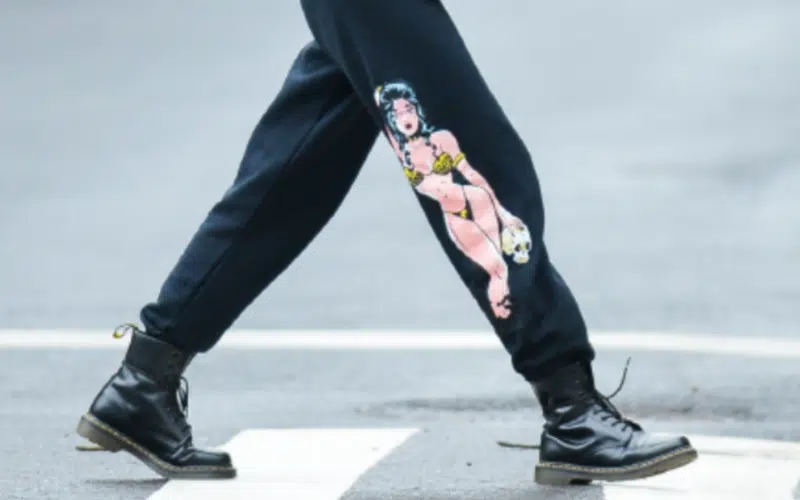Exploring Section 113(c) of the Copyright Act, an underutilized defense that could have changed the outcome of a recent infringement case.
There’s a provision of the Copyright Act that provides a simple and straightforward defense to an entire category of infringement claims. The only problem is that most people don’t know it exists.
I’m talking about section 113(c), which allows photographs of useful articles incorporating copyrighted works to be made and used without violating copyright law.
A useful article is an object like clothing or furniture that has an intrinsic utilitarian function that’s not merely to portray appearance or convey information. While these sorts of objects typically aren’t themselves eligible for copyright protection, they often contain pictures or designs which are protectable. If you own the copyright in a particular design, the Copyright Act gives you the exclusive right to put that design on t-shirts, coffee mugs and keychains which (spoiler alert) no one will ever put their keys on. Here’s an example, courtesy of my daughter Alyssa, who drew a picture of a hula hooping cat for this post. This is how her picture might look on some useful articles:



But section 113(c) makes clear that the copyright in these articles is subject to certain limitations:
In the case of a work lawfully reproduced in useful articles that have been offered for sale or other distribution to the public, copyright does not include any right to prevent the making, distribution, or display of pictures or photographs of such articles in connection with advertisements or commentaries related to the distribution or display of such articles, or in connection with news reports.
17 U.S.C. § 113(c)
This means that if Alyssa has sold her hula hooping cat t-shirts to the public, I could take my own photographs of one of the shirts in order to list them on eBay without infringing Alyssa’s copyright in the underlying design. Section 113(c) also allows me to use my photos in a blog post talking about how I flipped the t-shirts for a profit because Alyssa priced them too low. The local news could then take photos of the shirt to use in a story about what a lousy dad I am. You get the idea.
Unfortunately, however, Section 113(c) is like the Generation X of copyright law—it’s remarkably useful, underrated, and largely overlooked—even by copyright lawyers and judges. Case in point is a recent ruling out of the Central District of California involving clothing brand Deadly Doll. The court allowed Deadly Doll’s copyright infringement counterclaim to proceed against a photo that is almost certainly protected by 113(c)—if only the lawyers or the court had thought to cite the statute.
Vila v. Deadly Doll, Inc.
Vila’s Claim
The case has a pretty interesting set of facts, featuring an Inception-style infringement-within-an-infringement situation. One of Deadly Doll’s popular designs is a cartoon image of a bikini-clad pin-up girl holding a skull:

Deadly Doll has applied versions of its artwork to various products, including tops and sweatpants:


In 2020, photographer Carlos Vila took a picture of Russian model Irina Shayk wearing Deadly Doll sweats that incorporated its “Pin-Up Girl” artwork on the right pant leg. Vila licensed his photo to various online and print publications for use in articles about Shayk.

After seeing Vila’s photo of Shayk, Deadly Doll posted the image on its Instagram account. Vila later filed a lawsuit for copyright infringement against Deadly Doll based on the unauthorized reproduction and distribution of his photo.

Deadly Doll’s Counterclaim
So far, this is all pretty garden-variety stuff. But here’s where it gets interesting. Rather than simply defend (or settle) Vila’s copyright claim, Deadly Doll filed a counterclaim, asserting that Vila was the true infringer. Deadly Doll’s theory was that by taking a photo of Shayk wearing clothes that included its artwork, Vila had created an unlawful derivative work that reproduced its copyrighted image. According to Deadly Doll’s lawyers, not only did this mean that Vila’s copyright was invalid, but that his photo infringed Deadly Doll’s underlying design.
Vila’s Motion
Vila proceeded to file a motion for judgment on the pleadings. His main argument was that the photo couldn’t be considered an infringing derivative work simply because it captured Deadly Doll’s design. Otherwise, Vila asserted, “no photographer could ever take a picture of any individual wearing any item of apparel or accessories without obtaining licenses or waivers from any and all rightsholders in such apparel or accessories.” The result, Vila claimed, would be no less than the “demise of photography as an art form.” In the alternative, Vila asserted that his reproduction of Deadly Doll’s copyrighted work in connection with the photograph of Shayk was protected by the fair use doctrine.
Central District of California Judge Otis Wright denied Vila’s motion (read here). The court held that determining whether Vila’s photo was a derivative work based on Deadly Doll’s artwork raised factual issues that weren’t appropriately decided at the pleading stage of the lawsuit. While Judge Wright acknowledged Vila’s argument that allowing Deadly Doll’s claim would have a “chilling effect on the art of photography,” the court found that “Vila does not—and cannot—cite to any precedent stating that photographs can never be derivative works of any artwork displayed therein.” The court also held that it was too early in the case to determine whether Vila’s incorporation of Deadly Doll’s artwork into his photograph constituted fair use as a matter of law. This means that the lawsuit—including Deadly Doll’s counterclaim—will move forward.
Paging Section 113(c)
Deadly Doll’s counterclaim should have been dismissed, but not for the reasons advanced by Vila. While he’s undoubtedly correct about the chilling effect that Deadly Doll’s argument would have on photographers as a matter of copyright policy, the question of whether Vila’s photo was a derivative work is really beside the point.
If I went to a museum and took a high-res photo of one of the paintings in order to distribute posters of the art, that would constitute an infringing reproduction of the painting, regardless of whether my photo is considered to have “recast, transformed, or adapted” the underlying work. But that’s a different situation than Deadly Doll’s case, which involves the photograph of a useful article. The important thing is not the status of Vila’s photo as a derivative work, but the fact that he captured an object that’s subject to express statutory limitations under section 113(c).
To be sure, the fair use doctrine should also provide a defense for Vila under the facts of this case, but it requires a multi-factor balancing that courts often don’t want to apply before the parties have taken discovery, which can be expensive for both sides.
Section 113(c), on the other hand, doesn’t require any balancing, and the allegation in Deadly Doll’s counterclaim that Vila licensed his photograph to online and print publications should put his conduct squarely within section 113(c)’s application to “commentaries related to the distribution or display” of the useful articles “or in connection with news reports.” Likewise, news outlets that licensed the photo from Vila should be within their rights to use the picture to report on Shayk’s comings and goings and to comment on her fashion choices without violating Deadly Doll’s copyright in the drawing that happened to be printed on the sweat pants she wore that day.
Other Applications of Section 113(c)
There are a number of other situations in which invoking section 113(c) may prove useful:
- Some overzealous brand owners have been known to claim copyright in product labels (such as those on shampoo bottles) in order to try to prevent their products from being resold online on Amazon and other internet sites. So long as the product is genuine and has been lawfully obtained, the Copyright Act’s first sale doctrine will permit the sale, and section 113(c) will permit the use of photos of the product to advertise the sale. (To be safe, the seller should make sure to take its own photos of the product, as opposed to using images owned by the manufacturer.)
- On its face, section 113(c) only explicitly exempts “advertisements or commentaries related to the distribution or display” of useful articles, “or in connection with news reports.” However, there’s a decent argument that the statute should also apply to expressive works, like documentary films, that incidentally capture copyrighted works appearing in useful articles displayed on screen. While such incidental reproductions are almost certainly also permissible as fair use, the application of that doctrine is unpredictable enough that many filmmakers choose to blur out copyrighted designs on t-shirts and other articles rather than risk a lawsuit.
- Professor Rebecca Tushnet, who’s written a lot about 113(c) on her blogs over the years, has suggested that 113(c) might even encompass photographs or digital depictions of real-life tattoos. Under her theory, the “useful article” would be the human body on which the tattoo is affixed. While untested legally, this would provide a defense to some of the opportunistic tattoo copyright lawsuits I’ve written about before.

The Bottom Line
There have only been a handful of cases applying section 113(c), just two of which are published decisions. One of those cases completely misconstrued the statute by focusing on the circular inquiry of whether the defendant lawfully reproduced the plaintiff’s underlying artwork; the correct question is whether the plaintiff lawfully reproduced its work in useful articles. If so, a defendant’s photographs don’t constitute copyright infringement when used for the purposes set forth in the statute.
Section 113(c) has no doubt been used to ward off many more potential infringement claims before they’re actually filed, as I’ve done lots of times myself. But when cases like Deadly Doll do end up in court, hopefully more litigants and judges will take the opportunity to explore the contours of 113(c).
As always, please leave comments or questions below or at @copyrightlately on social media. Meanwhile, here’s a copy of the court’s order denying the motion filed against Deadly Doll. Just don’t search for 113(c); you won’t find it.







3 comments
Isn’t the problem with the 113 argument that the statute authorizes photographs of the useful article, but doesn’t say anything about the work? In other words, it seems that the point of that provision was to confirm that you can photograph a useful article, not that you can reproduce a pictorial work emblazoned on it.
If a copyrighted work is “lawfully reproduced in [a] useful article” how can you “mak[e], distribut[e], or display” a photograph of that useful article that doesn’t include the underlying copyrighted work?
Photograph it from the other side? Or have a fair use defense as to the work?